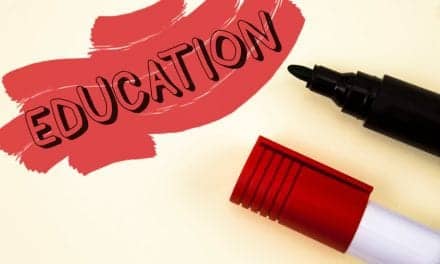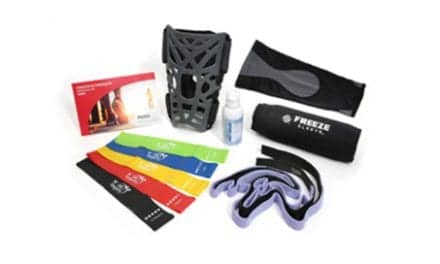PHOTO CAPTION: Physical therapists are the best-equipped individuals to guide an injured athlete back into competition.
Timing, treatment, and the right equipment help expedite the injured athlete’s return to sport
By Kalani McLaughlin, BA, HHP, AAS, PTA, and Dulcie Berube, BS, MSPT
Sports injuries are a common occurrence seen at outpatient physical therapy clinics. For athletes, injuries occur in a variety of settings and present with significant variations in dysfunction, pain, and time off from play. The most common sport injuries are overuse injuries and tears or sprains from both contact and non-contact scenarios. It’s a typical scenario — an athlete goes down on the field, a sports medicine team runs in to assess, then helps the athlete slowly maneuver off the pitch or court.
Most of the time, if an athlete is being seen in a clinic, he or she has had an injury serious enough to require the expertise of a physical therapist. The old traditional mantras of “walk it off,” “rub some dirt on it,” and “cinch the laces down and jog a little,” no longer apply in modern sports rehab. The newer adage of RICE (rest, ice, compression, elevation) for an acute phase is still relevant, but is becoming less appropriate. For physical therapists the science and research behind treating sports injuries has improved; promoting a shift toward active recovery that allows athletes to not just participate but to perform at their pre-injury levels.
[sidebar float=”right” width=”250″]Product Resources
The following companies offer products that can be used for athletic rehabilitation, fitness, and exercise programs of all types:
AlterG
www.alterg.com
Clarke Health Care Products
www.clarkehealthcare.com
Exertools
www.exertools.com
Fitter International Inc
www.fitter1.com
Magister Corp
www.magistercorp.com
Merrithew
www.merrithew.com
NZ Manufacturing Inc
nzcordz.com
OPTP
www.optp.com
Performance Health
www.performancehealth.com
Sissel USA
www.sisselshop.com
Stretchwell
www.stretchwell.com
The Hygenic Corp
www.theraband.com
VersaSlider
www.versaslider.com[/sidebar]
One Athlete, Many Stakeholders
Depending on a patient’s personality and family background, the athlete’s realization and discussion about not being able to participate in his or her chosen sport for 4 to 12 weeks can be the most difficult part of the treatment plan. Although the mechanism of injury or type of injury often differs, the question of “When can I play again?” is frequently heard by physical therapists. Every athlete wants to get better yesterday and the athlete’s family, as well as teammates and coaches, can be adamant about minimizing loss of training and playing time. At the high school and college levels a season can pass at lightning speed, and taking a few weeks off to recover may not be an option. Balancing active recovery with necessary rest time is an art that requires the analysis of many physical and psychological factors, as well as the motivation of the participant and their support group.
It can be helpful for some therapists to place themselves in their patients’ shoes throughout the course of care so they have a better understanding about the frustrations associated with being injured and unable to participate. No matter the age of the athlete, a good position for the therapist to assume for these cases is to provide the athlete with honesty and encouragement throughout the treatment and rehabilitation process. This includes being up front and realistic with the athlete’s parent(s) about the recovery timeline, the anatomy and kinesiology of the injured body part, risk factors, and ensuring that consistent communication is maintained regarding any progress that is being made, or at times, the lack of progress.
Three Recovery Phases
When the rehabilitation and return-to-play process begins, physical therapists are an integral component — and the individuals who are best equipped to guide an athlete back into competition. With the right equipment and care, a typical overuse injury that can limit activities for 4 to 6 weeks can be shortened to 1 to 2 weeks. For a more catastrophic injury such as a torn ligament or muscle, recovery that might take 6 to 12 months can be shortened to 3 to 6 months. The right equipment to allow athletes to move efficiently through the three recovery phases is as important to utilizing the correct interventions and rehabilitation methods.
Immediate Post-Injury Care
The faster an athlete can get to a qualified professional to assess and begin a rehabilitation program, the better the chances are for them to become a contributing member of their team again. Treatment typically centers around manual therapy to help restore mobility, joint mobilization and range of motion, modalities for pain control, and often some type of splinting, bracing, and compression. Manual intervention during the early stage of sports injury treatment is a tried-and-true technique for immediate post-injury care. Apart from the general passive range of motion techniques (PROM), some of the other beneficial techniques therapists like to use include:
• Joint mobilizations: This is one of the most common techniques learned in PT school, as well as one of the most-used techniques in general PT practice. The benefits behind joint mobilization have been proven time after time, which is a big reason why so many physical therapists use it on their athletes throughout the duration of their care.
• Mobilization with movement (MWM), sometimes referred to as the “tack and stretch”: This technique is used on larger areas of tissue such as the glutes, hamstrings, hip flexors, and sometimes on upper extremities, if appropriate. It involves “tacking” the distal or proximal portion of the involved tissue and lightly mobilizing the remaining tissue with passive movement.
• Low load long duration (LLLD): This technique involves a very low strain or stretch to the involved tissue with the patient experiencing nothing more than a slight stretch. An effleurage technique can be added to the area of interest while the LLLD technique is being performed.
There are also a variety of pieces of equipment or modalities that can be beneficial to this phase of treatment. Intelect Transport Ultrasound by Chattanooga in Lewisville, Texas, is useful when PROM interventions are poorly tolerated or when pain levels are moderately high, limiting PROM techniques. Electrical stimulation using the Intelect Transport 2-Channel Electrotherapy System, also by Chattanooga, with either a hot or cold pack can be used during the acute phase of recovery to aid in general inflammation and pain levels. Most of the time, this modality is performed at the end of treatment sessions. Dry needling has also proven very effective in treating athletes, especially for those with an injury consistent with the chronic overuse of a specific muscle group that can lead to hypertonicity of a muscle or signs and symptoms consistent with tendonitis.
Finally, taping is helpful for experimental improvements. For example, a common symptom of quadricep or hip weakness can lead to patellar pain. If a manual glide of the patella, lateral or medial ligaments, improves knee pain instantly, tape (such as KT Tape from Kinesiology Therapeutic, American Fork, Utah) helps recreate that manual glide for a duration of 2 to 3 days, if tolerated. Taping techniques are often forgiving and easy to explain to patients. If the patient does not enjoy the use of the tape over the next few days, or does not feel a benefit from it, he or she can simply remove it at home and something else can be tried.
Active Recovery
The active recovery phase begins with the reduction of pain and swelling of the injury. Soft tissue massages with limb positioning have shown to be extremely effective in reducing swelling. Instrumented Assisted Techniques typically produce great success in helping to facilitate acute and subacute edema. A variety of instruments by FIBROBLASTER in New York has unique shapes that allow proper myofascial releasing and tissue mobility. With improved tissue mobility, decreased swelling and improvement in myofascial restrictions, this allows the athlete to begin working on improving their range of motion, isolated strengthening, stabilization of the core, and improve functional movements.
BOSU Balance Trainer balls from BOSU, Ashland, Ohio; TheraBand Exercise and Stability Balls from Akron, Ohio headquartered company, TheraBand; DynaDisc Balance Cushions from Exertools, headquartered in Petaluma, Calif; and even the grass outdoors is beneficial equipment for the active recovery phase. These easy-to-use tools allow proprioception training right away, which has shown to moderately improve rehab during the early stages. Once basic exercises become easier for the athlete and endurance improves, sport-specific movement is introduced into their rehab using this equipment along with trampolines, lacrosse balls, and others.
Return to Play
Return-to-play can be the most difficult phase as it requires pushing the athlete to a level of failure, meaning we challenge the patient’s ability to give their maximum level of effort with all therapeutic activities and without adverse effects upon completion. The level of maximum effort can at times can be a vulnerable experience for an athlete. Their fear of re-injury or pain can cause anxiety over previous pain. This can limit their function and be a barrier to achieving previously set goals.
This phase requires the greatest finesse to receive maximal gains with the least amount of stress to the injury. The focus is typically on high-level dynamic balance, single leg activities, lateral movements, cutting or twisting drills, explosive power for stops and starts, jumping, and plyometrics. While it may be challenging, this stage is what moves athletes up significantly in their recovery so they may finally get back in the game. PTP
Kalani McLaughlin, BA, HHP, AAS, PTA, is the clinic director at Berube Physical Therapy in Kalispell, Montana. McLaughlin specializes in sports and orthopedic injuries, functional strength, mobility training and manual therapy. He works with high school and collegiate-level athletes as a coach and physical therapist.
Dulcie Berube, BS, MSPT, is the partner and regional director of operations at Berube Physical Therapy in Montana. Her experience includes neurological/stroke rehabilitation, total joint rehab, back and neck pain, joint therapy, aquatic therapy, and sports rehabilitation. Berube has a Masters of Science in Physical Therapy from the University of Montana in Missoula. For more information, contact [email protected].





